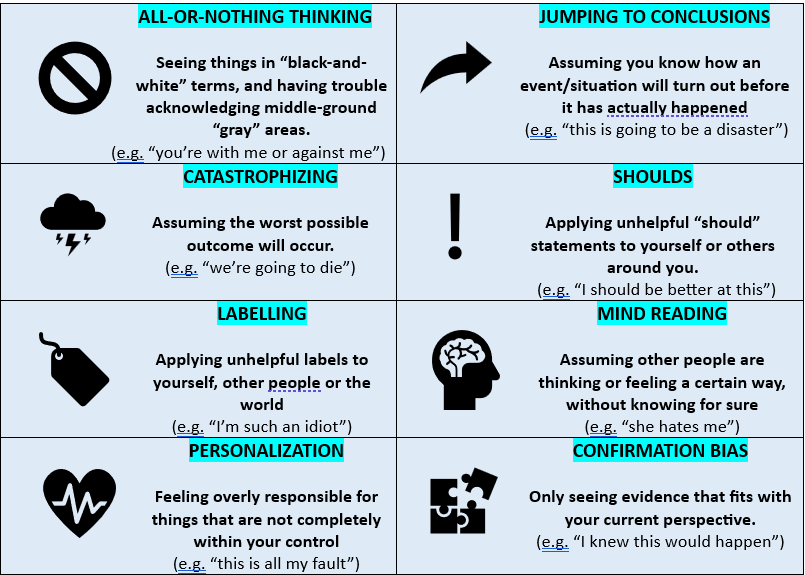THERAPY TALK: Thinking Traps
A common component of Cognitive-Behavioural Therapy (CBT) is the identification of “thinking traps” (also sometimes referred to as cognitive distortions or thought errors), which can be broadly described as “unhelpful” or “inaccurate” ways of thinking. The important thing to know about thinking traps is that they are universal (everyone has them) and completely normal!
When you think about it, the human brain is tasked with processing a huge amount of information every day. From the moment we wake up, to the moment we go to sleep, our brains are bombarded with tons of stimuli (or sensory inputs) that we must process and adjust to relatively quickly in order to keep moving forward in an efficient way. To illustrate this, just think about your inner dialogue on a 10-minute drive into work… I see the light is turning yellow, I guess I should slow down/apply brakes. I smell burning tar which reminds me there’s construction ahead – perhaps I should take a different route, so I’m not late. The song on the radio is making me feel annoyed, so I turn the dial to a different station. And here comes the rain… must turn on wipers. And so on, and so forth…

Part of what allows our brains to take in all this information, and not get bogged down, is to quickly sort it into categories and compartments. Essentially, if we come across an animal that looks like a dog and sounds like a dog, our brain is going to chuck it in the “dog” box and keep right on movin’ because we don’t have time to overthink it before the next piece of information arrives.
A great analogy for describing all this, is to imagine your brain as the luggage sorting facility within a massive airport. Can you picture it? A giant warehouse with tons of conveyor belts, moving countless pieces of luggage (or metaphorical “stimuli/inputs”) to their appropriate departing locations (or “interpretations/conclusions”). I’m sure you can appreciate that with all that information being processed and received, even the most highly functioning brain is bound to experience a certain amount of “error” or faulty sorting – and that’s where cognitive distortions come in!

While thinking traps are a completely normal (and, in fact, inevitable) part of being human – they do tend to occur at higher frequencies in those who suffer from mental health conditions like depression and anxiety. They also tend to fall into certain categories or patterns, based on things like personality type and presenting concerns. For example, it’s not uncommon for those with Generalized Anxiety Disorder (GAD) to experience a higher number of “catastrophizing” (or “worst-case scenario”) thoughts as compared to folks in the general public. Check out the graphic at the end of this blog for some additional examples of thinking traps!
So, now the million-dollar question: what do we do about these cognitive distortions? Well, this is one area of mental health where awareness really is (more than) half the battle. As we have explained, thinking errors are (to a certain extent) naturally occurring and it’s unrealistic to assume we can eliminate them entirely. But if we can (1) be aware of our personal tendencies towards certain thinking errors and (2) give name to them when they arise, this can go a long way towards defusing some of their power. Being able to call yourself out (e.g. “there I go catastrophizing again!”) allows you to put some healthy distance between you and your thoughts, and recognize that perhaps these worries are not a completely accurate representation of reality.
COMMON THINKING TRAPS
(note: this is not an exhaustive list)




